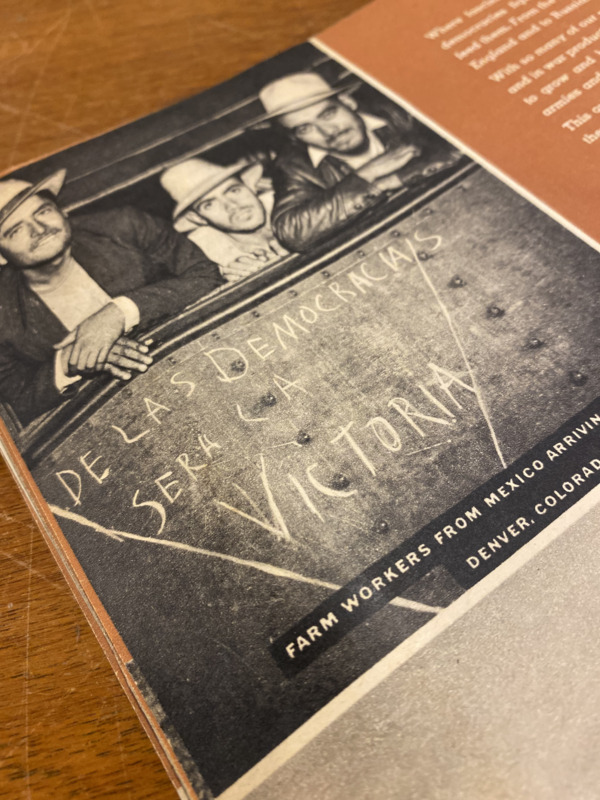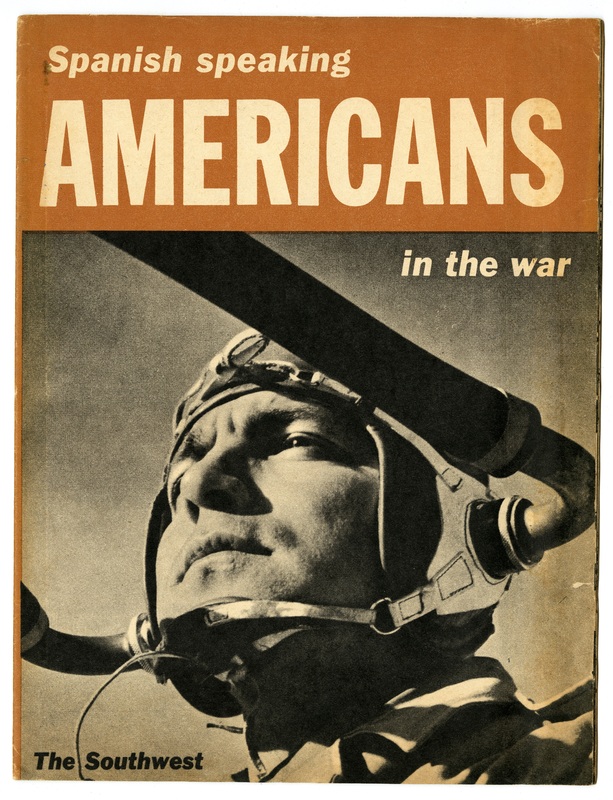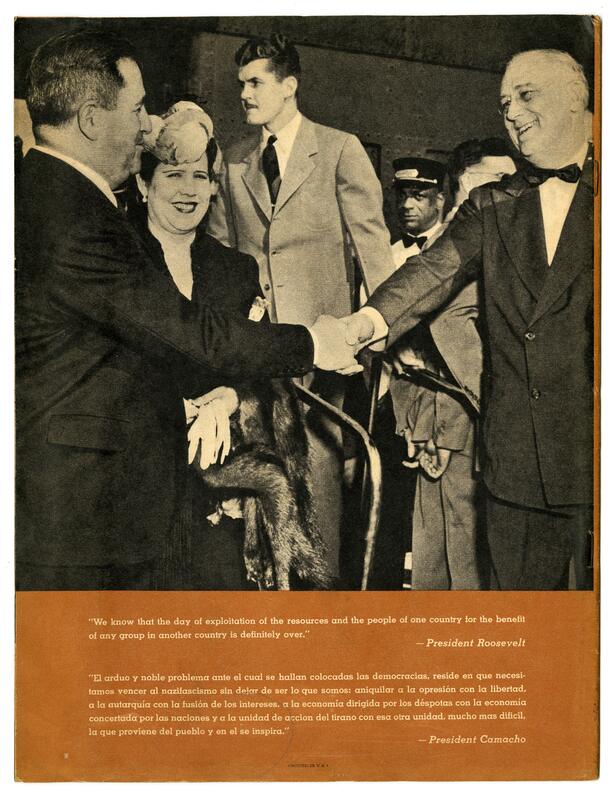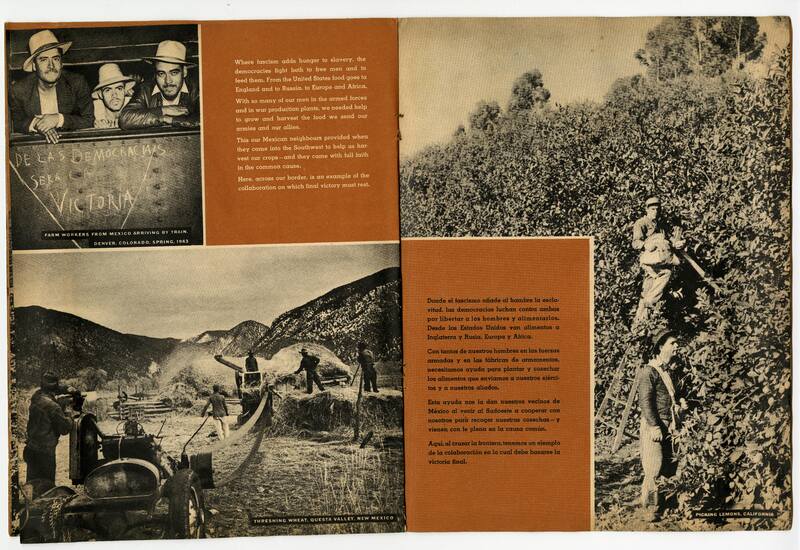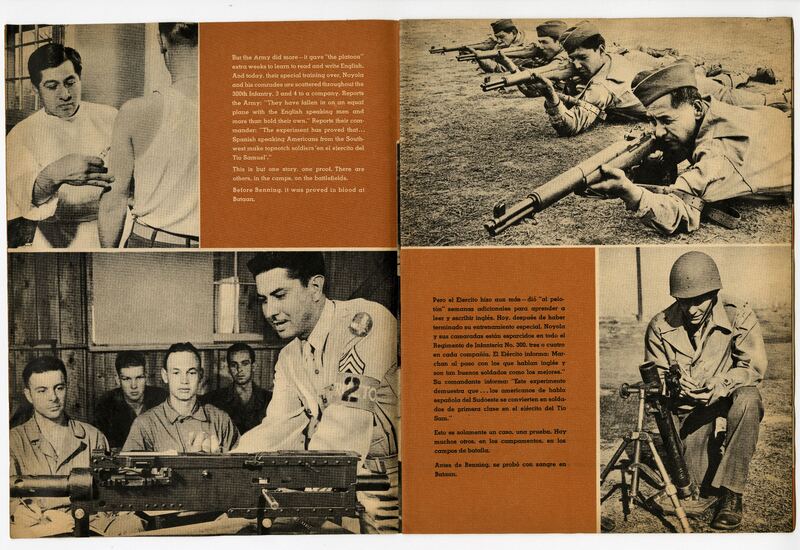Spanish Speaking Americans in the War
Item
- Title
- Creator
- Contributor
- Date
- Description
- Publisher
- Type
- Extent
- Language
- Format
- Rights
- Subject
- Illustrative content information
- Genre/form
- Book format
- Publication Information
-
En
Spanish Speaking Americans in the War
-
En
Office of the Coordinator of Inter-American Affairs
-
En
Written by: Charles Olson and Ben Shahn
Contributions by: The United States, Office of War Information
Photos contributed by Time Magazine
-
Es
Escrito por: Charles Olson y Ben Shahn
Contribuido por: Estados Unidos, Oficina de Información de Guerra
Contribuido fotografías por Time Magazine
-
En
1943
-
Es
1943
-
En
“Spanish-Speaking Americans in the War, Southwest” is a bilingual brochure published by the US government that details the influence that Hispanic Americans from this region had on the war, directly and indirectly. The pamphlet serves as propaganda to further encourage Spanish-speaking Americans to contribute and participate in the World War II efforts. This piece touches on experiences with bilingual platoons, the destruction of Bataan, and covers all the indirect ways Spanish Americans contributed such as farming and working in factories. The audience is both Spanish and English speaking, since it is presented in a bilingual structure in order to illustrate the language and cultural diversity of the United States at the time. This was a very important element because the US was rarely recognized as being linguistically diverse, and this drew attention to the growing interculturalism within the states. This piece captures the desperation that often plagues propaganda, but with an inspirational touch. It uses examples of the young men and women who have contributed to the War to encourage their parents and family and friends to make an effort on their behalf as well. The text begins with the story of a specific Spanish-speaking individual’s experience in the war effort and then culminates with a photo of President Roosevelt shaking hands with President Manuel Avila Camacho. Interestingly enough, this photo was the only one with monolingual captions: Spanish caption with the text from President Camacho, and an English quote from President Roosevelt. This is an interesting choice because it implies, somewhat, that each country has it’s own language, which is counterintuitive to the rest of the bilingual piece. That being said, this informational pamphlet was very unique for it’s time and was effective in capturing the effort to form a united front during war time.
-
Es
“Estadounidenses de habla hispana en la guerra, Suroeste” es un folleto bilingüe publicado por el gobierno EEUU que detalla la influencia que los hispanoamericanos de este región tuvieron en la guerra, directa e indirectamente. El folleto sirve como propaganda para alentar aún más a los estadounidenses de habla hispana a contribuir y participar en los esfuerzos de la Segunda Guerra Mundial. Esta pieza aborda experiencias con pelotones bilingües, la destrucción de Bataan y cubre todas las formas indirectas en que los hispanoamericanos contribuyeron, como la agricultura y el trabajo en las fábricas. La audiencia es de habla hispana e inglesa, ya que se presenta en una estructura bilingüe para ilustrar la diversidad lingüística y cultural de los Estados Unidos en ese momento. Este fue un elemento muy importante porque rara vez se reconocía que EE. UU. era lingüísticamente diverso, y esto llamó la atención sobre la creciente interculturalidad dentro de los estados. Esta pieza captura la desesperación que a menudo plaga la propaganda, pero con un toque inspirador. Utiliza ejemplos de hombres y mujeres jóvenes que han contribuido a la guerra para animar a sus padres, familiares y amigos a hacer un esfuerzo por ellos también. El texto comienza con la historia de la experiencia de un individuo de habla hispana específica en el esfuerzo de guerra y luego culmina con una foto del presidente Roosevelt dándole la mano al presidente Manuel Ávila Camacho. Curiosamente, esta foto fue la única con leyendas monolingües: leyenda en español con el texto del presidente Camacho y una cita en inglés del presidente Roosevelt. Esta es una opción interesante porque implica, de alguna manera, que cada país tiene su propio idioma, lo cual es contrario a la intuición del resto de la pieza bilingüe. Dicho esto, este folleto informativo fue único para su época y fue efectivo para capturar el esfuerzo por formar un frente unido durante la guerra.
-
En
Office of the Coordinator of Inter-American Affairs
-
En
Informational Pamphlet
-
Es
Folleto de Informaciónal
-
En
24 pages
-
Es
24 páginas
-
En
English and Spanish
-
Es
Inglés y Español
-
En
28cm x 21.5cm
-
En
This material is made available for use in research, teaching, and private study, pursuant to U.S. Copyright law. The user assumes full responsibility for any use of the materials, including but not limited to, infringement of copyright and publication rights of reproduced materials. Any materials used should be fully credited with the source. Permission for publication of this material, in part or in full, must be secured with the Head of Special Collections.
-
Es
Este material se ha hecho disponible para uso en investigaciones, tanto académicas como privadas, y en la docencia, de conformidad con la ley de derechos de autor de EE. UU. El usuario asume toda la responsabilidad por cualquier uso de los materiales, incluida, entre otras, la infracción de los derechos de autor y los derechos de publicación de los materiales reproducidos. La fuente de cualquier material utilizado debe acreditarse claramente. El permiso para la publicación de este material, en parte o en su totalidad, debe obtenerse de el/la/le Jefe de las Colecciones Especiales de WLU.
-
En
World War II
Spanish Speaking Americans
Southwest role in WWII
Propaganda
Office of War Information
-
Es
Segunda Guerra Mundial
Hispanohablantes en EEUU
Historia del Suroeste EEUU
Propaganda
Office of War Information
-
En
Black and white photographs throughout
“Photos courtesy of Life Magazine; Denver News; U.S. Army; Office of War Information Bureau of Industrial Economics; Department of Agriculture”
-
Es
Fotografías en blanco y negro en todas partes
Créditos para fotos aparecen en la última página:
¨Fotos cortesía de la revista Life; Noticias de Denver; Ejército EE.U; Oficina de Información de Guerra Oficina de Economía Industrial; Departamento de Agricultura.¨
-
En
Government publication, Propaganda Pamphlet
-
Es
Publicación gubermental, propaganda domestica de Segunda Guerra Mundial
-
En
Paperback
-
Es
Tapa blanda
-
En
“Printed in USA”
-
Es
Sitio de publicación: EEUU
